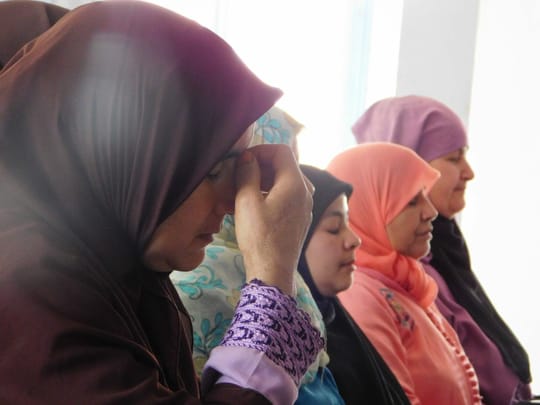Women’s Empowerment and Yoga in Rural Morocco and in Your Life

Women’s Empowerment and Yoga in Rural Morocco and in Your Life, Indepth News.
Catrin Waters

An Imagine empowerment session in Morocco (High Atlas Foundation, 2021)
Before you read this, I challenge you to pause and ask your body the question: how do you like the thoughts I think about you?
When we make an active choice to listen to ourselves, we access the power of introspection. But as you likely realized within the first sentence of this article, that often isn’t comfortable. It is almost taboo to honestly ask yourself how you are, and even rarer to have the skills needed to be able to listen to the response.
These skills are exactly what the High Atlas Foundation (HAF) seeks to develop within their IMAGINE empowerment workshops. The scene ranges from rural villages to bustling cities, yet the content and goal remain constant. HAF leaders guide groups of 25 Moroccan women through a 32-hour transformative experience. Ecstatic joy saturates a room where these women connect with their true selves, maybe for the first time. Turning about freely through guided dance helps the women create “turnarounds,” the term for the newly expanded beliefs that replace often deeply ingrained and harmful ones. To work through the discomfort of releasing old patterns of thought and behavior endows the women with the confidence to recognize their true potential.
HAF guides participants in goal-setting and affirmative visualizations surrounding seven core areas, including work, relationships, and sexuality. These powerful techniques are paired with practical education regarding Moroccan family law and placed in a spiritual context with passages from the Qur’an, permitting the women to understand their legal protections, pursue justice, and see themselves empowered through their spirituality.
This act of slowing down and listening is the core driving force of yoga, as well as HAF’s mission of empowerment. It forces us to switch from the mode of thinking into feeling. The conscious effort required to turn off our critical thinking brain and enter a more profoundly present state is not small and requires practice. However, there is incredible potential in the ramifications of this decision; in a study following 24 young women who identified themselves as chronically stressed, a three-month intervention of biweekly yoga classes resulted in statistically significant reductions in stress and anxiety, as well as overall improvement of physical health. Saliva samples from before versus after a 90-minute yoga class displayed a concrete and significant decrease in levels of cortisol, our bodies’ main stress hormone.
How does yoga achieve this? For one, yoga is not simply a sequence of strengthening acrobatic movements. The Sanskrit word “yoga” literally translates to “yoke” or “join.” It is an ancient Vedic philosophy that both recognizes and encourages a connection with the inherent interconnectedness of ourselves with everything in the universe. We are not separated from nature, but rather, embedded in it. This idea is not as far-fetched or spiritually lofty as one might assume, either: the widely accepted Big Bang Theory postulates that all that is, from here to the farthest edges of the universe, originated from a single point. You were once quite literally one with everything around you. Furthermore, the techniques of stretching, strengthening, breathing, and meditation are joined together in one complete practice to join your mind, body, and spirit. Yoga philosophy and teachings emerge from this idea, with scriptures emphasizing the importance of ahimsa, or non-violence.
Here enters the original question: how do you like the thoughts you think about yourself? Chances are that you haven’t been conditioned to hold yourself in very high regard, like many of the women in the IMAGINE workshops. According to ahimsa, this harm to ourselves through negative thoughts contributes to the prevalence of harm everywhere. In order to strive for better, you must first believe that you deserve it. Movement in yoga is a constant push and pull driven by the breath, steadily encouraging us to expand beyond our limits and find contentment in where we land at the moment.
The niyama or personal principle of svadhyaya encourages the importance of self-study. Yoga styles such as Yin encourage practitioners to find their edge of discomfort by holding deep tissue stretches for longer periods of time. This increases circulation and joint flexibility while opening channels of energy. Through directed breathwork, students are able to release tension and practice mental fortitude. When a negative thought or sensation interrupts the flow, yoga enables us to recognize it as a disconnection from our true presence and choose to let it go.
By enabling women to free themselves from self-constricting thought patterns, HAF promotes both personal and community growth. IMAGINE equips participants with tangible tools and support to lead lasting and meaningful development from a place of personal integrity. To date, nine groups of women have gone on to create income-generating cooperatives thoughtfully designed to further their specific community’s development. HAF continually supports these women by providing requested training related to these goals, and the groups formed through IMAGINE meet monthly thereafter to discuss current goals and progress.
As we reach the end of the article, I encourage you to take a moment for yourself to notice the ebb and flow of your breath. Return to the original question, even close your eyes if you feel comfortable, and listen. The principles of yoga and of HAF’s IMAGINE workshops are centered in this truth that acknowledging where you are is the first step to creating the life you most want.
Catrin Waters is a student at University of Virginia in the U.S. and a volunteer with the High Atlas Foundation, a U.S./Moroccan non-profit organization focused on sustainable development.